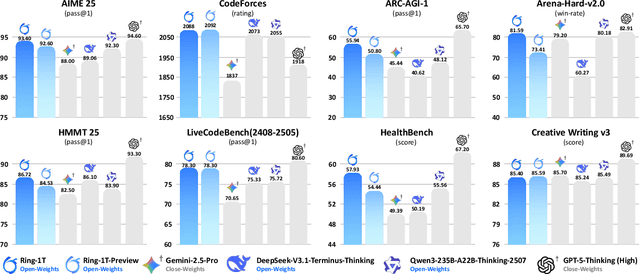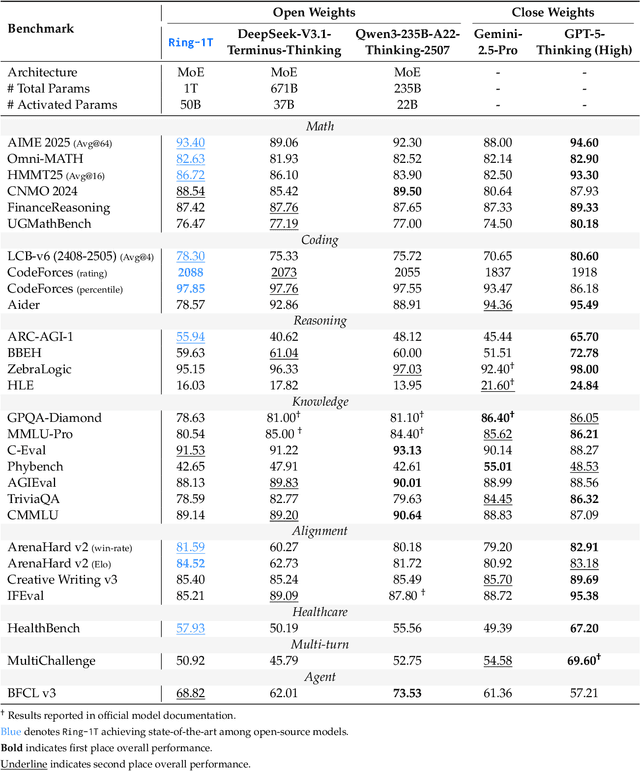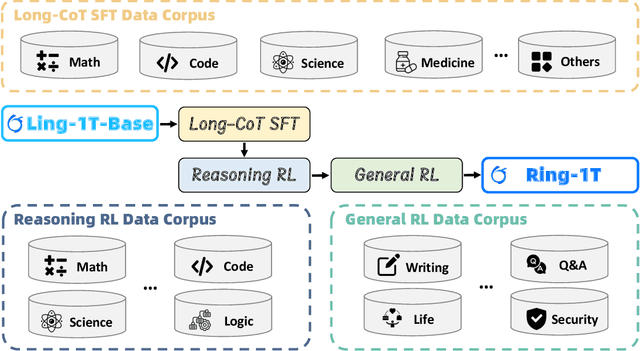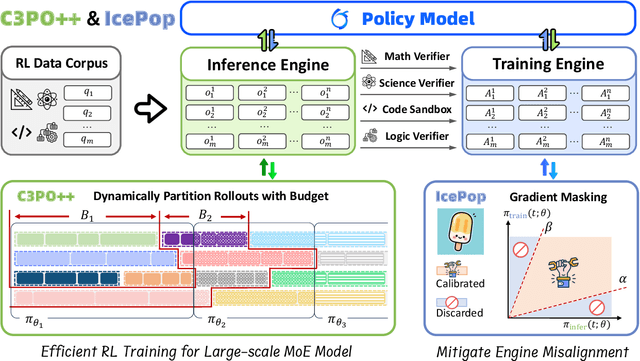Xudong Han
Event Extraction in Large Language Model
Dec 22, 2025Abstract:Large language models (LLMs) and multimodal LLMs are changing event extraction (EE): prompting and generation can often produce structured outputs in zero shot or few shot settings. Yet LLM based pipelines face deployment gaps, including hallucinations under weak constraints, fragile temporal and causal linking over long contexts and across documents, and limited long horizon knowledge management within a bounded context window. We argue that EE should be viewed as a system component that provides a cognitive scaffold for LLM centered solutions. Event schemas and slot constraints create interfaces for grounding and verification; event centric structures act as controlled intermediate representations for stepwise reasoning; event links support relation aware retrieval with graph based RAG; and event stores offer updatable episodic and agent memory beyond the context window. This survey covers EE in text and multimodal settings, organizing tasks and taxonomy, tracing method evolution from rule based and neural models to instruction driven and generative frameworks, and summarizing formulations, decoding strategies, architectures, representations, datasets, and evaluation. We also review cross lingual, low resource, and domain specific settings, and highlight open challenges and future directions for reliable event centric systems. Finally, we outline open challenges and future directions that are central to the LLM era, aiming to evolve EE from static extraction into a structurally reliable, agent ready perception and memory layer for open world systems.
Every Step Evolves: Scaling Reinforcement Learning for Trillion-Scale Thinking Model
Oct 21, 2025



Abstract:We present Ring-1T, the first open-source, state-of-the-art thinking model with a trillion-scale parameter. It features 1 trillion total parameters and activates approximately 50 billion per token. Training such models at a trillion-parameter scale introduces unprecedented challenges, including train-inference misalignment, inefficiencies in rollout processing, and bottlenecks in the RL system. To address these, we pioneer three interconnected innovations: (1) IcePop stabilizes RL training via token-level discrepancy masking and clipping, resolving instability from training-inference mismatches; (2) C3PO++ improves resource utilization for long rollouts under a token budget by dynamically partitioning them, thereby obtaining high time efficiency; and (3) ASystem, a high-performance RL framework designed to overcome the systemic bottlenecks that impede trillion-parameter model training. Ring-1T delivers breakthrough results across critical benchmarks: 93.4 on AIME-2025, 86.72 on HMMT-2025, 2088 on CodeForces, and 55.94 on ARC-AGI-v1. Notably, it attains a silver medal-level result on the IMO-2025, underscoring its exceptional reasoning capabilities. By releasing the complete 1T parameter MoE model to the community, we provide the research community with direct access to cutting-edge reasoning capabilities. This contribution marks a significant milestone in democratizing large-scale reasoning intelligence and establishes a new baseline for open-source model performance.
Distribution-Aligned Decoding for Efficient LLM Task Adaptation
Sep 19, 2025Abstract:Adapting billion-parameter language models to a downstream task is still costly, even with parameter-efficient fine-tuning (PEFT). We re-cast task adaptation as output-distribution alignment: the objective is to steer the output distribution toward the task distribution directly during decoding rather than indirectly through weight updates. Building on this view, we introduce Steering Vector Decoding (SVD), a lightweight, PEFT-compatible, and theoretically grounded method. We start with a short warm-start fine-tune and extract a task-aware steering vector from the Kullback-Leibler (KL) divergence gradient between the output distribution of the warm-started and pre-trained models. This steering vector is then used to guide the decoding process to steer the model's output distribution towards the task distribution. We theoretically prove that SVD is first-order equivalent to the gradient step of full fine-tuning and derive a globally optimal solution for the strength of the steering vector. Across three tasks and nine benchmarks, SVD paired with four standard PEFT methods improves multiple-choice accuracy by up to 5 points and open-ended truthfulness by 2 points, with similar gains (1-2 points) on commonsense datasets without adding trainable parameters beyond the PEFT adapter. SVD thus offers a lightweight, theoretically grounded path to stronger task adaptation for large language models.
K2-Think: A Parameter-Efficient Reasoning System
Sep 09, 2025Abstract:K2-Think is a reasoning system that achieves state-of-the-art performance with a 32B parameter model, matching or surpassing much larger models like GPT-OSS 120B and DeepSeek v3.1. Built on the Qwen2.5 base model, our system shows that smaller models can compete at the highest levels by combining advanced post-training and test-time computation techniques. The approach is based on six key technical pillars: Long Chain-of-thought Supervised Finetuning, Reinforcement Learning with Verifiable Rewards (RLVR), Agentic planning prior to reasoning, Test-time Scaling, Speculative Decoding, and Inference-optimized Hardware, all using publicly available open-source datasets. K2-Think excels in mathematical reasoning, achieving state-of-the-art scores on public benchmarks for open-source models, while also performing strongly in other areas such as Code and Science. Our results confirm that a more parameter-efficient model like K2-Think 32B can compete with state-of-the-art systems through an integrated post-training recipe that includes long chain-of-thought training and strategic inference-time enhancements, making open-source reasoning systems more accessible and affordable. K2-Think is freely available at k2think.ai, offering best-in-class inference speeds of over 2,000 tokens per second per request via the Cerebras Wafer-Scale Engine.
Towards Alignment-Centric Paradigm: A Survey of Instruction Tuning in Large Language Models
Aug 24, 2025



Abstract:Instruction tuning is a pivotal technique for aligning large language models (LLMs) with human intentions, safety constraints, and domain-specific requirements. This survey provides a comprehensive overview of the full pipeline, encompassing (i) data collection methodologies, (ii) full-parameter and parameter-efficient fine-tuning strategies, and (iii) evaluation protocols. We categorized data construction into three major paradigms: expert annotation, distillation from larger models, and self-improvement mechanisms, each offering distinct trade-offs between quality, scalability, and resource cost. Fine-tuning techniques range from conventional supervised training to lightweight approaches, such as low-rank adaptation (LoRA) and prefix tuning, with a focus on computational efficiency and model reusability. We further examine the challenges of evaluating faithfulness, utility, and safety across multilingual and multimodal scenarios, highlighting the emergence of domain-specific benchmarks in healthcare, legal, and financial applications. Finally, we discuss promising directions for automated data generation, adaptive optimization, and robust evaluation frameworks, arguing that a closer integration of data, algorithms, and human feedback is essential for advancing instruction-tuned LLMs. This survey aims to serve as a practical reference for researchers and practitioners seeking to design LLMs that are both effective and reliably aligned with human intentions.
Learning to Align, Aligning to Learn: A Unified Approach for Self-Optimized Alignment
Aug 11, 2025



Abstract:Alignment methodologies have emerged as a critical pathway for enhancing language model alignment capabilities. While SFT (supervised fine-tuning) accelerates convergence through direct token-level loss intervention, its efficacy is constrained by offline policy trajectory. In contrast, RL(reinforcement learning) facilitates exploratory policy optimization, but suffers from low sample efficiency and stringent dependency on high-quality base models. To address these dual challenges, we propose GRAO (Group Relative Alignment Optimization), a unified framework that synergizes the respective strengths of SFT and RL through three key innovations: 1) A multi-sample generation strategy enabling comparative quality assessment via reward feedback; 2) A novel Group Direct Alignment Loss formulation leveraging intra-group relative advantage weighting; 3) Reference-aware parameter updates guided by pairwise preference dynamics. Our theoretical analysis establishes GRAO's convergence guarantees and sample efficiency advantages over conventional approaches. Comprehensive evaluations across complex human alignment tasks demonstrate GRAO's superior performance, achieving 57.70\%,17.65\% 7.95\% and 5.18\% relative improvements over SFT, DPO, PPO and GRPO baselines respectively. This work provides both a theoretically grounded alignment framework and empirical evidence for efficient capability evolution in language models.
GRASPTrack: Geometry-Reasoned Association via Segmentation and Projection for Multi-Object Tracking
Aug 11, 2025Abstract:Multi-object tracking (MOT) in monocular videos is fundamentally challenged by occlusions and depth ambiguity, issues that conventional tracking-by-detection (TBD) methods struggle to resolve owing to a lack of geometric awareness. To address these limitations, we introduce GRASPTrack, a novel depth-aware MOT framework that integrates monocular depth estimation and instance segmentation into a standard TBD pipeline to generate high-fidelity 3D point clouds from 2D detections, thereby enabling explicit 3D geometric reasoning. These 3D point clouds are then voxelized to enable a precise and robust Voxel-Based 3D Intersection-over-Union (IoU) for spatial association. To further enhance tracking robustness, our approach incorporates Depth-aware Adaptive Noise Compensation, which dynamically adjusts the Kalman filter process noise based on occlusion severity for more reliable state estimation. Additionally, we propose a Depth-enhanced Observation-Centric Momentum, which extends the motion direction consistency from the image plane into 3D space to improve motion-based association cues, particularly for objects with complex trajectories. Extensive experiments on the MOT17, MOT20, and DanceTrack benchmarks demonstrate that our method achieves competitive performance, significantly improving tracking robustness in complex scenes with frequent occlusions and intricate motion patterns.
A Unified Anti-Jamming Design in Complex Environments Based on Cross-Modal Fusion and Intelligent Decision-Making
Jun 09, 2025Abstract:With the rapid development of radar jamming systems, especially digital radio frequency memory (DRFM), the electromagnetic environment has become increasingly complex. In recent years, most existing studies have focused solely on either jamming recognition or anti-jamming strategy design. In this paper, we propose a unified framework that integrates interference recognition with intelligent anti-jamming strategy selection. Specifically, time-frequency (TF) features of radar echoes are first extracted using both Short-Time Fourier Transform (STFT) and Smoothed Pseudo Wigner-Ville Distribution (SPWVD). A feature fusion method is then designed to effectively combine these two types of time-frequency representations. The fused TF features are further combined with time-domain features of the radar echoes through a cross-modal fusion module based on an attention mechanism. Finally, the recognition results, together with information obtained from the passive radar, are fed into a Deep Q-Network (DQN)-based intelligent anti-jamming strategy network to select jamming suppression waveforms. The key jamming parameters obtained by the passive radar provide essential information for intelligent decision-making, enabling the generation of more effective strategies tailored to specific jamming types. The proposed method demonstrates improvements in both jamming type recognition accuracy and the stability of anti-jamming strategy selection under complex environments. Experimental results show that our method achieves superior performance compared to Support Vector Machines (SVM), VGG-16, and 2D-CNN methods, with respective improvements of 1.41%, 2.5%, and 14.51% in overall accuracy. Moreover, in comparison with the SARSA algorithm, the designed algorithm achieves faster reward convergence and more stable strategy generation.
DeepMath-Creative: A Benchmark for Evaluating Mathematical Creativity of Large Language Models
May 13, 2025

Abstract:To advance the mathematical proficiency of large language models (LLMs), the DeepMath team has launched an open-source initiative aimed at developing an open mathematical LLM and systematically evaluating its mathematical creativity. This paper represents the initial contribution of this initiative. While recent developments in mathematical LLMs have predominantly emphasized reasoning skills, as evidenced by benchmarks on elementary to undergraduate-level mathematical tasks, the creative capabilities of these models have received comparatively little attention, and evaluation datasets remain scarce. To address this gap, we propose an evaluation criteria for mathematical creativity and introduce DeepMath-Creative, a novel, high-quality benchmark comprising constructive problems across algebra, geometry, analysis, and other domains. We conduct a systematic evaluation of mainstream LLMs' creative problem-solving abilities using this dataset. Experimental results show that even under lenient scoring criteria -- emphasizing core solution components and disregarding minor inaccuracies, such as small logical gaps, incomplete justifications, or redundant explanations -- the best-performing model, O3 Mini, achieves merely 70% accuracy, primarily on basic undergraduate-level constructive tasks. Performance declines sharply on more complex problems, with models failing to provide substantive strategies for open problems. These findings suggest that, although current LLMs display a degree of constructive proficiency on familiar and lower-difficulty problems, such performance is likely attributable to the recombination of memorized patterns rather than authentic creative insight or novel synthesis.
Feature Alignment and Representation Transfer in Knowledge Distillation for Large Language Models
Apr 18, 2025Abstract:Knowledge distillation (KD) is a technique for transferring knowledge from complex teacher models to simpler student models, significantly enhancing model efficiency and accuracy. It has demonstrated substantial advancements in various applications including image classification, object detection, language modeling, text classification, and sentiment analysis. Recent innovations in KD methods, such as attention-based approaches, block-wise logit distillation, and decoupling distillation, have notably improved student model performance. These techniques focus on stimulus complexity, attention mechanisms, and global information capture to optimize knowledge transfer. In addition, KD has proven effective in compressing large language models while preserving accuracy, reducing computational overhead, and improving inference speed. This survey synthesizes the latest literature, highlighting key findings, contributions, and future directions in knowledge distillation to provide insights for researchers and practitioners on its evolving role in artificial intelligence and machine learning.
 Add to Chrome
Add to Chrome Add to Firefox
Add to Firefox Add to Edge
Add to Edge